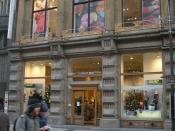Background
Benetton Group S.p.A. was one of Europe's largest clothing brands in 1994, consisting of three main brands. United Colors of Benetton, which focused on men and women's clothing, was the largest of the three and comprised over 60% of sales for the Benetton Group. 012 United Colors of Benetton, which focuses on children under the age of 12, possessed 18.5% of sales. Sisley was the higher fashion brand in the group, though it consisted of less than 12% of sales.
Benetton products are sold in over 8,000 retail outlets, yet Benetton owns and operates less than 50 of these outlets. Benetton uses 500 subcontractors and many joint ventures to design, assemble, and package the products for Benetton. With a network of 83 Benetton agents, the company can keep an eye on the market and offer help to retailers on how to market the product to the consumer in a retail setting.
Problem Definition
Benetton has gained international notoriety for its controversial communication strategies. Benetton uses its promotion budget to provoke a debate of controversial issues like racism, war, and poverty in order to encourage brand image. Since the early 1980's Benetton has tried to promote "All the colors of the World", and the campaign slogan "United Colors of Benetton" has been in use since 1985.
Benetton has faced a world of outrage since their adoption of this communication, rather than a traditional advertising strategy. Benetton has performed very well over the last thirty years but faces the problem of increased anger and threats of legal action due to their explicit way of addressing issues such as AIDS, terrorism, violence, racial issues, and immigration. Benetton does not believe that they are using these ads to sell their clothing, but to address and fight bigger issues that face societies...


